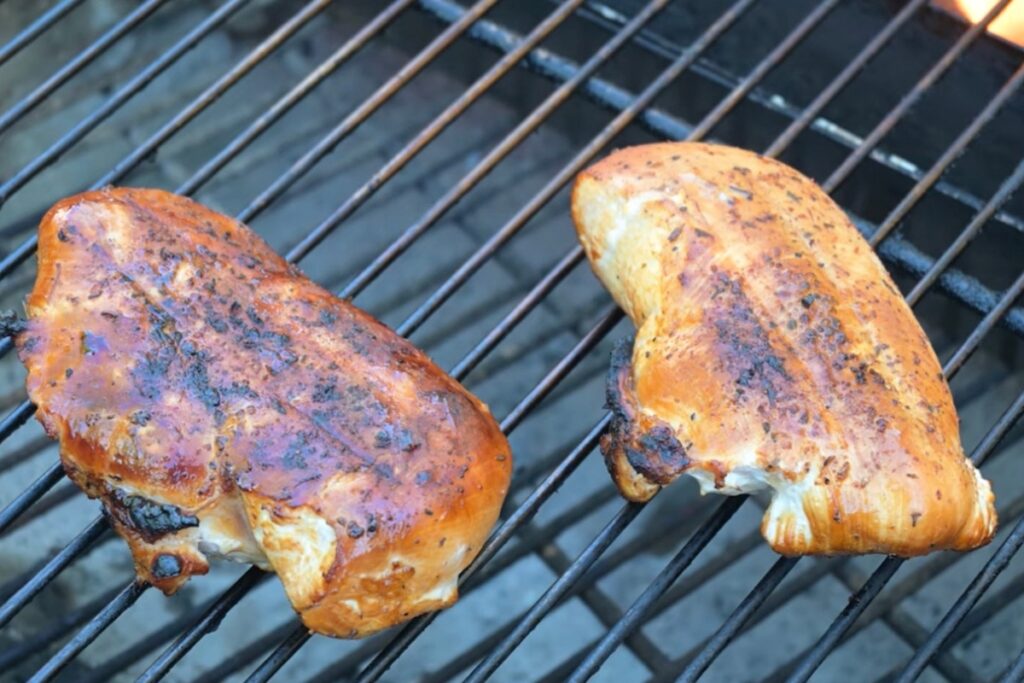When cooking chicken, we all know that we have to be super careful and make sure that we cook it properly to kill any harmful bacteria.
But what temperature is safe? Does chicken need to be kept at a certain temperature for a set number of minutes? One thing is for sure – cooking chicken can be difficult when you don’t know how!
Is 145° Safe For Chicken?
Salmonella cannot survive at 145° (63°C) for more than 9 minutes. So chicken that is safe to eat has been heated to at least this temperature for at least that long.
Keep in mind that all of the chicken will need to be 145° (63°C) to be safe to eat. This is why the internal temperature of the meat you are cooking is taken – if the middle is this warm, you can be sure that all of the meat is.
To be on the safe side, most recipes or cooking instructors will direct you to cook your chicken until its middle reads 165° (75°C). This will help the harmful bacteria be killed quicker and guarantee that all of the chicken is safe to eat, without having a negative impact on the eating experience.

Risks Of Undercooked Chicken
Salmonella is the chief reason why it is essential to only ever eat properly cooked chicken.
Salmonella is a type of bacteria that causes food poisoning. Over 1 million Americans every year contract food poisoning from salmonella, with some people requiring significant medical intervention to survive.
Salmonella will ideally live in meat that is somewhere between 35° and 117° (2°C and 47°C). At these temperatures the bacteria will multiply at astonishing speeds, quickly rendering an improperly stored piece of chicken inedible.
So, to kill all of these bacteria and make the food safe to eat again, you need to apply heat. This is the safest way to disinfect food. Be sure to cook your chicken meat thoroughly before consumption as chicken is less dense than beef or pork. This makes it easier for bacteria to penetrate deep into the muscle fibers.
Should I Cook Chicken After 145°?
Generally, it is recommended that chicken is cooked until it is 165° (around 75°C) in the middle. This is best for chicken breasts as this cut of meat tends to dry out easily, but you may prefer to cook chicken thighs for a little bit longer.
However, it is not just temperature that is important for making chicken safe to eat. You need to make sure that it is kept at a safe temperature for a specific number of minutes.
At 145° (63°C), salmonella cannot survive. However, this temperature is on the threshold of survivability for this bacteria so it will take around 9 minutes before all of the salmonella microbes have been killed.
Theoretically, you can kill off all of the salmonella bacteria at much lower temperatures, as long as you keep that temperature constant for the appropriate period. Cooking your chicken to 136° (57°C), for example, is perfectly safe as long as this temperature is held for over an hour. That said, this style of cooking is impractical for many home cooks so it is far more common to cook for less time at higher temperatures.

At 165° (75°C), all of the salmonella bacteria in the chicken will be killed in under 20 seconds. This is far more practical and easy to work out – you do not need to keep your eye on a timer or the clock for extended periods, and you don’t need to constantly stare at the thermometer. You just cook, count to 20, then leave it aside to rest.
Keep in mind that it is essential that chicken is made safe to eat if you are cooking for those with compromised immune systems. This includes the elderly, someone who is pregnant, children, or anyone with a known underlying health condition. These groups are far more likely to fall ill should the chicken they eat contain living salmonella.
The Cooking Process
Ever wondered what happens to your chicken as it cooks? It is quite a fascinating change on a molecular level!
Anything below 120° (48°C) and the muscle fibers in the meat look like long strands. These are the strands that you can see when you cut into the raw chicken meat. It is these strands that form what some refer to as the ‘grain’ of the meat and can make slicing against it difficult.
Once temperatures begin to rise to over 120° (48°C), fluid is forced out of the meat as proteins begin to coagulate. Once you hit 140° (60°C), all of the fibers have coagulated. It is this coagulation that gives the cooked chicken its opaque and white appearance.
Ever wondered why chicken can get so dry? It is because at 150° (65°C), the proteins begin to contract. As they shrink, water is squeezed out of the meat. If you do not let your chicken rest and re-absorb some of this moisture you will be left with a dry mess.
Chicken thighs or legs are still tender at 180° (83°C) because of the collagen content. Collagen is found in the dark parts of the chicken meat and begins to turn to gelatin at around 160° (71°C). This jelly-like substance helps seep into the meat and protect it from the heat, guaranteeing a juicy morsel at the end of cooking.

Should I Truss My Chicken?
You may find that some recipes suggest that you truss up your chicken when you cook it. This is no longer recommended as a safe cooking practice.
When you truss up a chicken, you block the inner thigh from the heat. This creates a nice little crevice that will not get to the correct temperature, potentially allowing salmonella to remain unscathed.
You also need to remember that the thighs of the meat take longer to cook than the white meat. Preventing the dark meat from hitting the correct temperature will prolong the overall cooking time of your whole bird and could cause the thigh meat to taste gummy. This will happen when the collagen hasn’t been given enough time to break down into gelatine.
Our recommendation? Leave the legs untied and your chicken untrussed – it’ll taste better!
Quick Tips For Raw Chicken
- Refrigerate your chicken until you are ready to use it. This will keep your meat too cold for bacteria to multiply.
- Don’t rinse your chicken before you cook as you are likely to send contaminated water over your sink and countertops.
- Wash your hands before and after handling raw chicken. Be sure to use soap and warm water for the best sanitation.
- Be aware of your utensils – don’t use the same equipment for cooked chicken as you used for raw without washing first. Failure to do so will result in cross-contamination and render the whole dish unsafe.
- Use a thermometer. This is the quickest and easiest way to make sure that your chicken is at the correct temperature, and has been at the right temperature for the correct period of time.
Final Thoughts
You can eat chicken that has been heated to 145° (63°C), as long as it has been kept at that temperature for 9 minutes. This is enough time for all of the harmful bacteria to be killed.
To be safe, we recommend that you cook chicken until the internal temperature reads 165° (75°C). At this temperature, salmonella bacteria will not be able to survive for more than a few seconds.
- Porterhouse Vs. Ribeye - May 16, 2022
- How Long To Smoke A Brisket Per Pound – Explained - May 16, 2022
- What Is A Tomahawk Steak? - May 16, 2022








